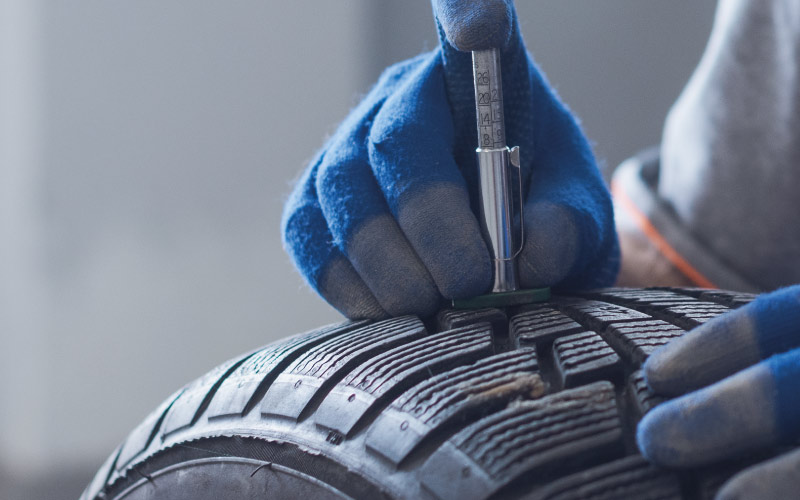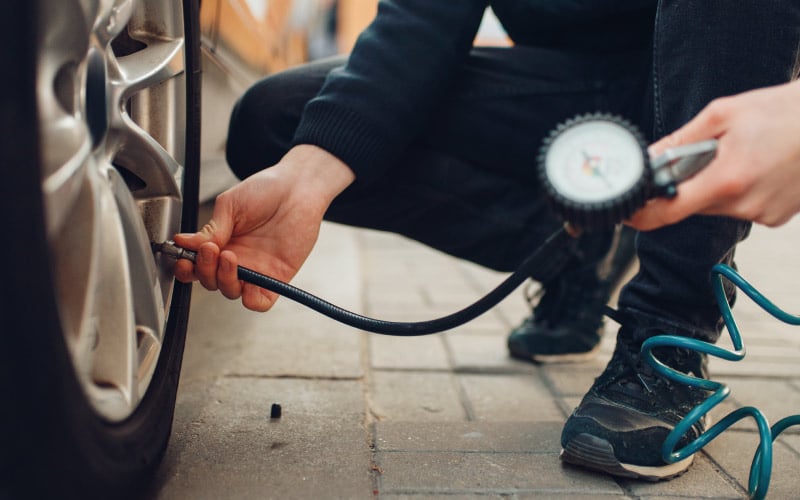Here's How to Check Your Taxi Tyres - And Why It's Important!

Table of Contents
1. Why is tyre safety important?
2. What you need to know to keep your tyres safe in the winter
3. How to check your taxi’s tyres
4. Why is it important to check your taxi’s tyres?
5. Tips on how to drive safe in your taxi
6. Get more for your business at The Taxi Centre
As the main point of contact between your taxi and the road surface, tyres are incredibly important. Without them, your journeys would be a lot less smooth, and undoubtedly less safe.
Here’s how you should check your taxi’s tyres to make sure they’re in top shape. Plus, some driving tips to help you drive safer in your taxi.
Why is tyre safety important?
Last month was Tyre Safety Awareness Month. A time to raise awareness about the importance of having safe, legal tyres.
Though tyre safety isn’t just important in October, but all year round. You may think your tyres are just another part of your taxi, but they actually have a big responsibility when it comes to road safety.
Whenever you accelerate, brake, or turn the wheel of your taxi, your tyres have the task of making sure this is done safely on the road. The tread – the grooved pattern running around your tyres - helps to deflect water and improve grip on wet surfaces.
Without a good grip on the road, steering, braking and acceleration – or any other form of movement– would be extremely dangerous.
That’s why it’s always important to make sure your taxi’s tyres are in good condition, and that they have enough tread depth remaining.
Having good quality taxi’s tyres is not only important for your safety, but for compliance with the law. In the UK, having a tyre below the legal limit could land you with a £2,500 fine for each tyre, and three points on your licence.
That’s something you don’t want to risk – especially as a taxi driver!
What you need to know to keep your taxi’s tyres safe in the winter
There’s one thing that can make it incredibly difficult for your taxi’s tyres to maintain a good grip – and that’s snow or ice.
In the winter months, you can expect the roads to be wet or damp more often, but once this water freezes overnight this can lead to ice.
Your taxi tyres will find it more difficult to maintain a good grip on the road when driving over snow and ice.
You’ll notice there is often a crunching sound when driving over fallen snow, and the steering may feel a bit lighter.
It’s important to reduce your speed and drive carefully in these conditions to avoid the wheels on your taxi locking or skidding due to friction.
Here are some things you can do to make sure the tyres on your taxi are safe this winter:
- Make sure they are correctly inflated (and not over or underinflated)
- Park your taxi on a flat surface if possible, or in a garage overnight
- Change your taxi’s tyres if you spot any signs of damage, no matter how small
- Watch out for any punctures, cuts or bulges in your tyres

How to identify all of these things? Give your taxi’s tyres a good check over.
How to check your taxi’s tyres
So how do you check your taxi’s tyres? Not to worry – it’s fairly easy and won’t take you much time.
When checking the tyres of your taxi, you’ll need to inspect the tread depth – for example, how deep the grooves in your tyres are. To remain road-legal, your tyres must have 1.6mm of tread depth remaining across breadth of the tyre.
Here’s how to check your taxi’s tyres to see whether they are roadworthy:
- Take a 20p coin and slot it into the grooves of your taxi’s tyre
- If you can see the outer band of the coin, your tyres are above the legal limit and no action is required
- If you can see the band, then your tyres may need replacing
There are other ways you can check your taxi’s tyres, including using tyre tread wear indicators or a tyre tread depth gauge.
Tyre tread indicators are sometimes embossed on the tyre wall as a guide, with some form of mark indicating the outer tread. If your tyre is level with these markings, then it’s time for a replacement.
Tyre tread gauges are special tools used to measure each individual tyre groove by inserting it into the grooves of your tyre.
Whichever method you choose, as a taxi driver you’ll need to complete these checks more regularly since you’ll be driving more than normal drivers. Consider checking your taxi’s tyres at least once a month or every two weeks, especially before longer journeys such as airport runs.


Why is it important to check your taxi’s tyres?
As a taxi driver, it’s more important than ever to check your taxi’s tyres regularly. Every day, you are responsible for the safety of numerous passengers who enter your taxi.
Just as it’s your responsibility to make sure all passengers are wearing seatbelts, it’s also up to you to make sure your taxi is safe to drive at all times.
With a £2,500 fine per tyre and three penalty points, illegal tyres could have a serious impact on both your finances and reputation as a taxi driver.
By checking your taxi’s tyres regularly, you can avoid getting into trouble with the law and make sure your taxi is fit for business.
Tips on how to drive safe in your taxi
Safe driving is incredibly important as a taxi driver. After all, no operator will hire a taxi driver unless they pass stringent tests and complete all necessary training.
You’ll likely know this already, but there are a few things you should practice daily when transporting passengers:
- Drive smoothly and calmly at all times. Do not brake harshly, speed around corners or do anything else that could cause your passengers discomfort
- Maintain a safe distance from the vehicle in front and make sure to stick to the speed limit
- Always use your indicators when making a turn and do this in plenty of time
- Stay focused on the road ahead and be on the lookout for any potential hazards
- Remain calm if another driver makes an error on the road which causes you to slow down, stop or change direction. Customers won’t appreciate road rage!
- Make sure to drop passengers off in a safe location away from oncoming traffic
- Always make sure you have enough fuel for each journey to avoid breakdowns
- Make sure you get enough sleep and are well-rested before each shift
In the winter, driving conditions can change suddenly on the roads. During this time, there is poorer light quality with less sun and more wet, windy, or slippery conditions.
Always drive according to the weather and make sure to reduce your speed where needed. Remember that national speed limits indicate up to – based on the conditions of the road – and are not a target.
Read our top taxi driving tips this winter for more information on how you can tackle the changing weather conditions.
We’ve even put together a guide to driving your taxi in snow, rain and fog, so you know exactly what to expect.
Get more for your business at The Taxi Centre
At The Taxi Centre, we do more than just help you to find the perfect new taxi. We’re also a friend you can turn to for all your taxi business needs.
From taxi finance and government grants, to helping you save money and improve your customer service.